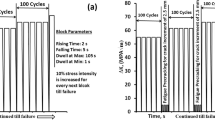Abstract
In this paper the effect of specimen thickness on fatigue crack growth with the spatial distribution of material properties is presented. Basically, the material resistance to fatigue crack growth is treated as a spatial stochastic process, which varies randomly on the crack surface. The theoretical autocorrelation functions of fatigue crack growth resistance with specimen thickness are discussed for several correlation lengths. Constant ΔK fatigue crack growth tests were also performed on CT type specimens with three different thicknesses of BS 4360 steel. Applying the proposed stochastic model and statistical analysis procedure, the experimental data were analyzed for different specimen thicknesses for determining the autocorrelation functions and probability distributions of the fatigue crack growth resistance.
Similar content being viewed by others
References
Broek, D., 1988, “The Practical Use of Fracture Mechanics,” KAP.
Buto, S., Sugie, H. and Okazaki, A., 1977, “Fortran and Numerical Analysis,”Baifukan.
Itagaki, H., Ishizuka, T. and Huang, P. Y., 1993, “Experimental Estimation of the Probability Distribution of Fatigue Crack Growth Lives,”Prob. Eng. Mech., Vol. 8, pp. 25–34.
Kim, S. J., 1999, “An Analysis of Crack Growth Rate Due to Variation of Fatigue Crack Growth Resistance,”Trans. KSME, Vol. 23, No, 7, pp. 1139–1146.
Kozin, F. and Bogdanoff, J. L., 1989, “Recents Thoughts on Probabilistic Fatigue Crack Growth,” Part 2.Appl. Mech. Rev., Vo. 42, No. 11, S121-S127.
Lapetra, C., Mayo, J. and Dominguez, J., 1996, “Randomness of Fatigue Crack Growth under Constant Amplitude Loads,”Fat. Fract. Eng. Mater. Struct., Vol. 19, pp. 589–600.
Mcmaster, F. J., Tabrett, C. P. and Smith, D. J., 1998, “Fatigue Crack Growth Rates in AL-Li Alloy, 2090. Influence of Orientation, Sheet Thickness and Specimen Geometry,”Fat. Fract. Eng. Mater. Struct., Vol. 21, pp. 139–150.
Ortiz, K. and Kiremidjian, A. S., 1986, “Time Series Analysis of Fatigue Crack Growth Rate Data,”Eng. Fract. Mech., Vol. 24, pp. 657–676.
Paris, P. C. and Erdogan, F., 1963, “A Critical Analysis of Crack Growth Propagation Law,”J. Bas. Eng. (Trans. ASTM D) Vol. 85, pp. 528–536.
Putatunda, S. K. and Rigsbee, J. M., 1985, “Effect of Specimen Size on Fatigue Crack Growth Rate in AISI4340 Steel,”Eng. Fract. Mech., Vol. 22, pp. 335–345.
Shim, D. S. and Kim, J. K., “A Stochastic Analysis on Variation of Fatigue Crack Propagation due to Thickness Effect,”Trans. KSME, Vol. 22, No. 8, pp. 1523–1532.
Sobczyk, K., 1993, “Stochastic Approach to Fatigue: Experiments, Modelling and Reliability Estimation,”Springer Verlag Wein-New York.
Tanaka, S., Ichikawa, M. and Akita, S., 1981, “Variability of m and C in the Fatigue Crack Propagation Law,”Int. J. Fract., Vol. 17, R121.
Virker, D. A., Hiliberry, B. M. and Goel, P. K., 1979, “The statistical nature of fatigue crack propagation,”J of Eng. Mat and Tech., ASME, Vol 101, pp. 148–153.
Yamazairi, F. and Shinozuks, M., 1986, “Digital Generation of non-Gaussian Stochastic Fields,” Technical Report,Columbia Univ. Press, pp. 211–235
Author information
Authors and Affiliations
Corresponding author
Rights and permissions
About this article
Cite this article
Kim, SJ., Itagaki, H. & Ishizuka, T. Effect of specimen thickness on the statistical properties of fatigue crack growth resistance in BS4360 steel. KSME International Journal 14, 1041–1050 (2000). https://doi.org/10.1007/BF03185058
Received:
Revised:
Issue Date:
DOI: https://doi.org/10.1007/BF03185058




